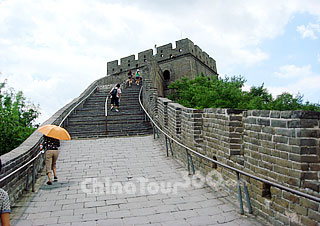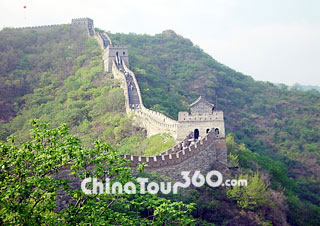 Badaling, Beijing
Badaling, Beijing Great Wall of the Ming Dynasty
Great Wall of the Ming Dynasty Juyongguan Pass
Juyongguan Pass
![]() Warring States Period, Qin Dynasty, Han Dynasty, and Ming Dynasty great walls
Warring States Period, Qin Dynasty, Han Dynasty, and Ming Dynasty great walls
The Yuan Dynasty (1271 - 1368) was the only period following the unification of China that the country was ruled by an ethnic minority – the Mongols. After the establishment of the Ming dynasty (1368 - 1644), the nomadic Mongol tribes (especially the Wa-la and Tartar) retreated to Mobei grasslands to the north but frequently invaded the Chinese border. Later to the northeast of China the Nüzhen People grew in strength and also posed a threat. In order to consolidate frontier defense, the rulers continued to restore and extend the wall during their two hundred and seventy six years reign. The project was on such a gigantic scale that it far exceeded work during any other dynasty.
Since Zhu Yuanzhang was the leader of a peasant uprising, he knew clearly how important the frontier defense was. He ordered the start of the construction of the Great Wall once he came to the throne, including the restoration of city walls throughout the country. Built of stone blocks and bricks instead of the rough materials like rammed earth and wood, the wall of the Ming Dynasty was solid than ever before due to advanced techniques. So, it acted as a strong defense against the invaders. Also, it is safe to say that the whole project of China's Great Wall started in the Spring and Autumn Period (770 - 476BC) and was finally completed by the end of the Ming Dynasty.
The progress of the Ming Great Wall construction can be divided into three stages. During 1369 – 1447, the project was mainly to reinforce the walls of the Northern Wei, Northern Qi and the Sui Dynasty. The most representative sections were the Outer Wall from northwest Beijing to Datong of Shanxi, and border passes from Shanhaiguan Pass to Juyongguan Pass. During the mid-Ming Dynasty (1448 - 1566), the increased threat from the Wa-la and the Tartars became the main source of trouble for the feudal country. So, it was quite essential to rebuild the wall in the north and add more fort piers. In addition, in order to further consolidate the dominion, numerous towns of military importance were built during this period all over the country, such as in the north of Gansu, Ningxia, Shaanxi, Shanxi, Hebei and Liaoning provinces. While at the end of the Ming Dynasty (1567 - 1620), Mongol tribes negotiated with Ming rulers for peace and the border was opened for trade. The Nüzhen People in Northeast China remained a major threat and so the central government ordered the rebuilding of the section of wall in the east of Liaoning province, and changed the routes of the wall in some sections.
According to the report by the State Administration of Cultural Heritage and the State Bureau of Surveying and Mapping in 2009, the Great Wall of the Ming Dynasty was from Hushan Town beside the Yalü River to Jiayuguan Pass in Gansu province. The total length was over 8,851 kilometers (5,496.5 miles) through Liaoning, Hebei, Beijing, Shanxi, Inner Mongolia, Shaanxi, Ningxia, Gansu, and Qinghai. The section of the wall between Shanhaiguan Pass and Jiayuguan Pass is the best-preserved.







